 Mens Ice Hockey World Championships
Mens Ice Hockey World Championships
Badge

Poster

Established
1920 (105 years old)
First Recorded Event
2000-04-29
Current Season
2026
Current Round
200
Sport
Location
Worldwide
Gender
Male
TV Rights
US - ESPN [2021]

Description
The Ice Hockey World Championships are an annual international men's ice hockey tournament organized by the International Ice Hockey Federation (IIHF). First officially held at the 1920 Summer Olympics, it is the sport's highest profile annual international tournament. The IIHF was created in 1908 while the European Championships, the precursor to the World Championships, were first held in 1910. The tournament held at the 1920 Summer Olympics is recognized as the first Ice Hockey World Championship. From 1920 to 1968, the Olympic hockey tournament was also considered the World Championship for that year.
The first World Championship that was held as an individual event was in 1930 in which twelve nations participated. In 1931, ten teams played a series of round-robin format qualifying rounds to determine which nations participated in the medal round. Medals were awarded based on the final standings of the teams in the medal round. In 1951, thirteen nations took part and were split into two groups. The top seven teams (Pool A) played for the World Championship. The other six (Pool B) played for ranking purposes. This basic format would be used until 1992 (although small variations were made). During a congress in 1990, the IIHF introduced a playoff system. As the IIHF grew, more teams began to participate at the World Championships, so more pools (later renamed divisions) were introduced.
The modern format for the World Championship features 16 teams in the championship group, 12 teams in Division I and 12 teams in Division II. If there are more than 40 teams, the rest compete in Division III. The teams in the championship play a preliminary round, then the top eight teams play in the playoff medal round and the winning team is crowned World Champion. Over the years, the tournament has gone through several rule changes. In 1969 body-checking in all three zones in a rink was allowed, helmets and goaltender masks became mandatory in the early 1970s and in 1992 the IIHF began using the shootout. The current IIHF rules differ slightly from the rules used in the NHL. From the 1920 Olympics until the 1976 World Championships, only athletes designated as "amateur" were allowed to compete in the tournament. Because of this, players from the National Hockey League and its senior minor-league teams were not allowed to compete, while the Soviet Union was allowed to use permanent full-time players who were positioned as regular workers of an aircraft industry or tractor industry employer that sponsored what would be presented as an after-hours amateur social sports society team for their workers. In 1970, after an agreement to allow just a small number of its professionals to participate was rescinded by the IIHF, Canada withdrew from the tournament. Starting in 1977, professional athletes were allowed to compete in the tournament and Canada re-entered. The IIHF requires that players are citizens of the country they represent and allow players to switch national teams provided that they play in their new nation for a certain period of time.
Canada was the tournament's first dominant team, winning the tournament 12 times from 1930 to 1952. The United States, Czechoslovakia, Sweden, Great Britain and Switzerland were also competitive during this period. The Soviet Union first participated in 1954 and soon became rivals with Canada. From 1963 until the nation's breakup in 1991, the Soviet Union was the dominant team, winning 20 championships out of 26. During that period, only three other nations won medals: Canada, Czechoslovakia and Sweden. Russia first participated in 1992 and the Czech Republic and Slovakia began competing in 1993. In the 2000s, the competition became more open as the "Big Six" teams – Canada, the Czech Republic, Finland, Russia, Sweden, and the United States – as well as Slovakia and Switzerland have become more evenly matched.
As this tournament takes place during the same period as the later stages of the NHL's Stanley Cup playoffs, many of that league's top players are not available to participate for their national teams or have only become available after their NHL teams have been eliminated, after playing 90+ games. North American teams, and especially the United States, have been criticized for not taking this tournament seriously. For example, USA Hockey often sent teams made up of younger NHL players alongside college players, not using top level stars even when they are available.
The 2015 World Championship, held in Prague and Ostrava, Czech Republic, was the most successful to date in terms of overall attendance; it was visited by 741,690 people and average attendance was at 11,589.![]()
![]()
Seasons
2026 |  2025 |  2024 |  2023 | ||||
Teams
Trophy Icon

Last 5 winners
 Czech Republic Ice Hockey (2024)
Czech Republic Ice Hockey (2024)Fanart




Banner

Other Links
Website | Youtube |















